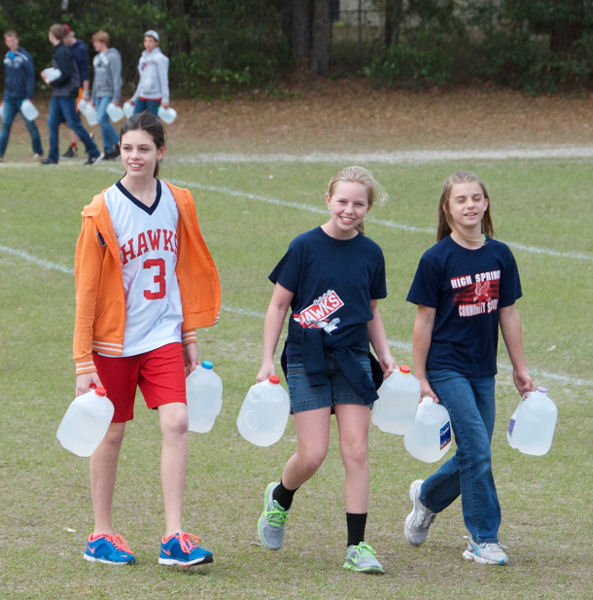More than 3000 buildings from across the United States took the challenge to reduce energy use during 2012 in hopes of being named winner of the U.S. Environmental Protection Agency (EPA) Energy Star National Building Competition: Battle of the Buildings.
Entrants tracked energy and cost savings using an EPA online energy-tracking tool and reported progress at the launch, midpoint, and end of the competition, according to the “Battle of the Buildings 2012 Wrap-Up Report.” At the conclusion of the competition, EPA named winning buildings as those that demonstrated the largest percentage reduction in energy use, adjusted for weather and the size of the building, the report says.

Third top water savers, High Springs (Fla.) Community School, educated students about the value of water by hosting a Long Walk to Water event. For the event, students carried water to raise money to fund a Rotary International (Evanston, Ill.) well-constructing project. Photo courtesy of Judith K. Weaver, High Springs Community School.
For 2012, EPA added the “water savers” category because water consumption is tied closely to overall building-energy use and provides another way to approach energy efficiency, according to the agency. Nearly 400 competitors in this category tracked and attempted to reduce water and energy use to be named a top water saver. Water-saving entrants collectively saved more than $1 million, according to EPA.
The 2012 water savers winner was the Oak Street office of Webster Bank (Waterbury, Conn.) in Brockton, Mass. The building saved 80% in water use during the year. The company also had three other office buildings rank in the competition’s top 10 water savers: The Rocky Hill, Conn., South office ranked fourth by saving 63%; the Broad Street Windsor, Conn., office ranked fifth by saving 62%; and the Cranston, R.I., office ranked seventh by saving 58%, according to the report.
The THG Energy (Tulsa, Okla.) Bryce Building in Tulsa ranked as the second top water savers, reducing water use by 79%. The building, which was preparing for a remodel, saved water by changing its heating, ventilating, and air-conditioning system to one that uses less water; converting to high-efficiency toilets; and reprogramming the irrigation system to water less frequently, according to the report.

As an educational component of the Long Walk to Water event, students learned about groundwater and aquifers from a Florida park ranger. As part of the presentation, students built groundwater filtration systems using ice cream, sprinkles, and gummy bears. Photo courtesy of Weaver.
High Springs (Fla.) Community School ranked as the third top water savers, reducing water use by 70%. The school reduced water use by finding and fixing leaks, renovating bathrooms by installing water-saving valves on toilets and faucets, and reducing automatic irrigation to stop overwatering, the report says.
“We have saved a huge amount of water,” said Judith K. Weaver, a teacher at the school. “Our students and faculty are thrilled with the recognition and encouraged to continue our efforts.”
School actions did not stop with energy- and water-use reductions but also took advantage of the updates to educate students and the community, the report says. This included involving the school’s Green Club members to find leaks; holding educational presentations for students; asking more than 400 students in grades 4 through 8 to read the book A Long Walk to Water, which describes how children in Africa carry water for up to 6 hours a day; taking students to the water exhibit at the University of Florida (Gainesville) Natural History Museum; and hosting a Long Walk to Water fundraising event. For the Long Walk to Water event, 350 students volunteered to walk and carry water to raise $2200 to fund a Rotary International (Evanston, Ill.) well-constructing project, the report says.

To celebrate World Water Day, High Springs Community School educated students about native species that require healthy water habitats. Students were able to hold this baby alligator and learn about protecting their habitats. Photo courtesy of Weaver.
“Outreach to our students to educate them about water conservation continues through lessons, as well as continued hands-on applications, such as our xeriscaped gardens for the upper grades and the Green Club garden,” Weaver said. The school also plans to teach students how to maintain the gardens and will continue to incorporate water conservation books into the curriculum, she added.
The 2013 Battle of the Buildings competition, which began in May, will add three more categories, including 20% or greater reduction in energy-use intensity, recognition for building tenants that reduce the energy use of their leased space by the greatest percentage, and the most valuable participant based on energy efficiency and total number of scorecard points from awareness and education efforts, according to EPA.
— Jennifer Fulcher, WEF Highlights









July 3, 2013
Featured